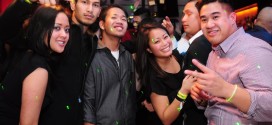Thanksgiving is almost upon us. This quintessentially “American” holiday harkening back to the days when colonists would share a feast with the Native Americans has morphed in Asian American households across the country. We asked some of our regular contributors to share some of their unique Thanksgiving memories as Asian Americans.
If you have any Thanksgiving memories you would like to share, we invite you to send them to editor@asianfortune.com We will post a few on our website: www.asianfortunenews.com in honor of this holiday of gratitude.
Vania Cao
When your mom hates the taste of turkey meat and the closest single branch of your extended family lives a 9 hour flight away, warm and fuzzy family-filled American holidays like Thanksgiving are nothing more than a few extra days off class or work to sleep in and laze around procrastinating on laundry. The cheery images of golden-haired Americans sitting at a big table around a steaming turkey and plates of cranberry sauce and pumpkin pie, jostling for elbow space with cousins and aunts with pinching fingers, with a dog begging for bones under the table, was as real to my Thanksgiving experiences as the Moon Festival is to an Amish kid living in rural Pennsylvania. Images like these make me feel a little bit like a stranger in my own homeland, a foreigner in my own country.
Because our feast at Thanksgiving had quite a different look and taste and smell. Although there would just be the four of us in the house like any other evening, our big dining room table would be cleared off and wiped down, the one we bought used and then sanded and lacquered together as a family, the one usually reserved for guests. My mother would go through the backbreaking tedium of broiling meats, julienning veggies, soaking black wood-ear fungus, and stir-frying up a storm, spending her afternoon readying the table for our Thanksgiving dinner, Northern Chinese-style. The minimum load for the table was always 6 unique dishes, but she was usually wasn’t satisfied until she had 8. Because of this, 6 and 8 have always been both auspicious, and delicious.
The old pressure cooker would be rattling on and off like a bomb about to explode with its load of rich stew bubbling inside, filling the house with the tantalizing aromas of pork, ginger, onion, carrot, five spice powder and soy sauce. Fragrant rice steam, scrambled egg-and-tomato, bubbling tofu soup and Asian eggplant with saute’d garlic, my favorite, would inevitably join the aromatic mix, alongside the smell thrown off by other dishes like beef tendon, spicy pig ear and my mom’s signature Chinese salad mix. The comforting, familiar *chunk-chunk-chunk* of her big cleaver on the cutting board and the sharp sizzle of shrimp hitting the hot wok marked the long, slow minutes until pig-out time, in tune with the rumbles of hunger from my belly.
My little sister and I were the dish bearers, on a constant solemn march from the kitchen to the big table as each dish was ejected from the wok, each responsible for a precious load of steaming and glistening eats. Place settings were put down, laser-cut vessels dug out from the dusty glass cabinet. My mom would get red wine in her glass; there was juice for my sister and I, and my Dad would crack open his bottle of Maotai (Chinese liquor) and pour himself a finger of the clear, pungent stuff, sipping and stealing a chopstick-full here, and chopstick-full there, until my mother scolded him.
As sometime during my childhood I had been deemed the family “Rice Master”, I was in charge of dishing out rice onto everyone’s fancy-occasion plates, and then we’d all dig in with gusto. Soft, savory pork fat, crunchy-soft Chinese cabbage, slithery-cool cellophane noodles, the bite of green onion slivers, a mouthful of soft, shining white rice, a sip of juice, fragrant fish and slippery peas, a mouthful of thick soup swirled with egg flowers and little tofu cubes, and the occasional sharp burst of a stray star anise fragment hiding in pork gravy: this is the taste of my Thanksgiving.
After the feast, of course there would be a giant pile of dirty and congealing dishes to be washed by my sister and I, groaning and protesting with extended bellies. While there isn’t any claim of massive tryptophan reserves in Chinese food, sleepy, happy exhaustion is the universal result of stuffing your face, whether your mom made it happen by cramming her hands up the inside of a giant frozen turkey, or by scraping the hairs off a boiled pig’s ear.
Derek Mong
My family would always have Thanksgiving dinner in some form or another, but being from a relatively Westernized Asian American household, the traditions of East and West would often make manifest in a bizarre assortment of dishes and treats at our Thanksgiving table—which was, for the record, always round, never rectangular.

On the Western side, we’d generally have a slow-roasted Turkey with all the fixings: corn, mashed potatoes, stuffing, green beans, and a casserole or two, but it would always be complemented with a dish or two (or three or four) that was uniquely Asian. For instance, we might also have a delicious serving of “hong shao rou” (or “red braised pork”) or “mapo doufu” (or “spicy tofu”). Our side dishes would be equally as interesting: it wouldn’t be unusual to have a serving of “zha jiang mian” (or “noodles mixed with sauce”) or “suan cai” (or “fermented cabbage”) right by the cornbread and cranberry sauce. This hemispheric balance would seem to ebb and flow with the years; I can distinctly remember one year when we replaced the Thanksgiving Turkey entirely and cooked several Peking Ducks instead!

My parents—who were born and raised in Beijing and Hong Kong, but studied in Europe during their formative years before moving to the United States—would generally be involved in creating the Asian dishes, while my younger counterparts and I would dabble for Thanksgiving recipes on FoodNetwork.com to craft our own contributions. It was our family’s own version of “Iron Chef” if you will; taking the mystery ingredient—a nostalgic sense of homeliness and comfort—and offering our own myriad interpretations based on the cultural forces that shaped our lives.
Never fully Westernized, yet not entirely Asian, the Thanksgiving table might be a metaphor for broader societal forces at play within the formation of my cultural identity; yet, however bizarre from the outside, these dishes would always coalesce into a singular, unified meal after a long day of cooking (and watching the Macy’s Thanksgiving Day Parade)—a meal that was distinctively comforting and what I will always associate with home.
Daphne Domingo
I grew up in a single-parent household and our Thanksgivings were usually spent as guests at some random friend’s, usually a neighbor that had kids around my age. While those holidays were certainly a good time filled with good food and good company, nothing ever felt like that special homey-bonding feeling that would be advertised on TV year after year. We were always guests for the day, not necessarily “family.”
Back in the late 1990s, my roommate, Tony Jenson, and I decided to host Thanksgiving dinner at our place in San Francisco. I had just moved into his apartment after having lived upstairs for two years and we thought it would be the perfect opportunity to throw a unique housewarming celebration. We came up with a unique and indulgent menu, not only to treat our guests but ourselves, too.
Of course, there were standard dishes like the turkey, which he agreed to tackle, especially since I’d never done one before and only heard the primary task was how to avoid dryness. He declared to roast it in a bag, which was a fairly new tactic at the time, and of course, I was more than willing to have him try. Meanwhile, I tackled the stuffing making.
Thanksgiving afternoon we combined eating with playing games like Sharp Shooters, Rat’s Ass and gin rummy. It didn’t matter that many of them hadn’t met before, some were longtime friends of Tony’s, some were longtime friends of mine, some were neighbors, and a couple were brand new acquaintances. One guest happened to be an old friend I grew up with that I hadn’t seen since high school and ran into the week before.
The next morning, guests who had stayed the night were treated to caramelized cranberry French toast, along with whatever other leftovers they wanted, while we watched movies during the day.
It was incredibly touching to have people from our different social circles not only come to our home, but stay. It truly defined the holiday of unity for me and I learned a new meaning of family, the urban family. About 15 years later, I’m still friends with just about everyone who attended, including Tony with whom I’ve been discussing the possibility of my visit for Christmas this year.
 Asian Fortune Your source for all things Asian American
Asian Fortune Your source for all things Asian American



